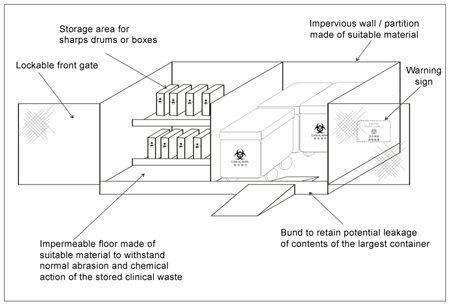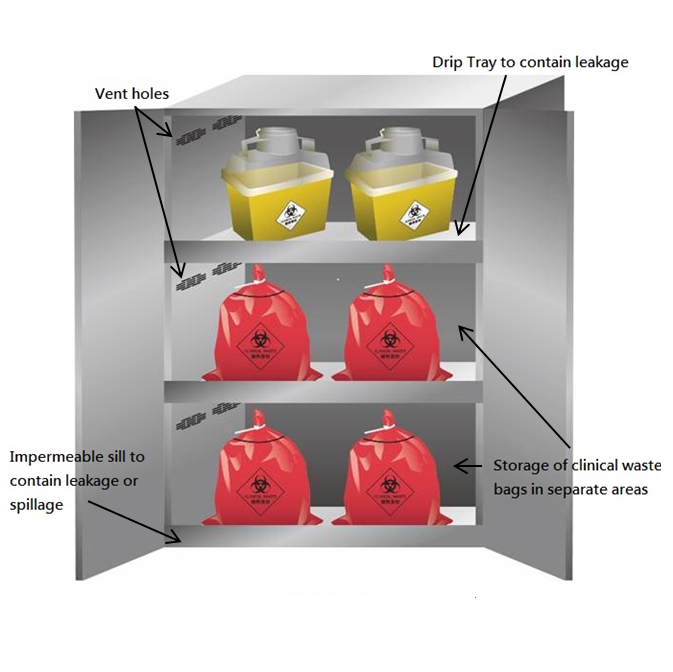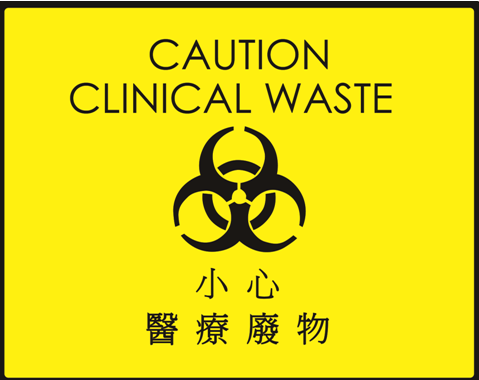Handing and On-Site Storage of Clinical Waste for Major Producers
Transfer to On-Site Storage Area
General Requirements
For hospitals, clinical waste containers after being properly sealed and labelled should be transferred from the place of waste generation to an on-site storage area for temporary storage before collection. The containers should be handled with care and should not be left unattended during the transfer of the waste.
Trolleys or Carts Used for the Transfer of Clinical Waste within the hospital
Dedicated trolleys and carts should be used for the transfer of clinical waste on the premises. They should be designed and constructed according to the following specifications :
- The surfaces should be smooth, with no rough or sharp edges (which may damage the packaging of clinical waste);
- Impermeable materials should be used and the design should provide containment of any spillage of waste which may occur in transit;
- The trolleys or carts should be easily cleaned and drained; and
- The overall design should allow the bags and containers to be properly retained in the trolleys or carts, and to be safely loaded/unloaded and handled without difficulty.
The trolleys and carts should be cleaned at the end of each working day and thoroughly disinfected at regular intervals.
Storage of Clinical Waste
Provision of On-site Storage Area
Waste producers should provide suitable and adequate area for temporary on-site storage of clinical waste. The storage area should be located close to the sources of waste generation so as to minimize waste handling and to facilitate management control.
The storage area should be enclosed on at least three sides by wall, partition or fence. The enclosures should be rigidly erected and fixed to the area. An illustration of a storage area layout is shown in Figure 2. Depending on the waste generation quantity, a small lockable cupboard as shown in Figure 3 can also be used. Where possible, all clinical waste should be contained in transit skips inside the storage area.
Figure 2 Schematic Drawing of a Storage Area for Clinical Waste
Figure 3 Schematic Drawing of a Clinical Waste Storage Cupboard Specifications of Storage Area
The design of storage area will depend on the quantity and types of clinical waste involved. In all cases, the storage area should be designed to meet the following requirements and specifications:
- Used for storage of clinical waste only;
- With an adequate capacity to cater for the quantity of waste produced and the frequency of waste collection;
- Exhibiting a warning sign on the external surface of the vertical structure of the area at or near its entrance. A warning sign is shown in Figure 4;
- Protecting the integrity of the waste packaging;
- Protecting the waste containers therein from the weather (wind, rain, flooding, etc);
- With cover and lockable door to prevent access by unauthorized persons, animals, birds, and free from rodent and insect infestations;
- With adequate ventilation and lighting;
- Sited on a well-drained, impervious hard-standing area provided with wash down facilities, or as a lockable room or cupboard which can be cleaned and disinfected;
- Installed away from any air-intake of building ventilation;
- Not adjacent to any food stores or food preparation areas; and
- Accessible to waste collection vehicles where possible.
Refrigeration of Clinical Waste
Clinical waste that may rapidly decompose (e.g. waste containing human or animal tissues) should be stored under refrigeration to prevent nuisance such as obnoxious odour.
Other Requirements
Where any clinical waste with liquids is stored, the storage area should be designed to be capable of containing any spillage of liquids. The area should be cleaned and disinfected promptly and thoroughly in case any waste spillage occurs.
Clinical waste containers should not be compacted to avoid damaging their packaging when placed in the storage area. Stacking of bagged clinical waste should also be avoided as far as possible to avoid damage to the bags.
Collection Point
Subject to the authorization granted by EPD, a waste producer may use his premises where he produces clinical waste (e.g. hospital, clinic, medical laboratory) to provide temporary storage area as an “on-site collection point”, for receiving clinical waste generated by him in other premises or delivered by other small waste producers.
Waste producers who intend to set up on-site collection points must obtain authorization from EPD and follow such terms and conditions specified in the authorization. The objective is to minimize the risks of pollution to the environment and the danger to public health that might be caused by the operation of these collection points.
Licensed collectors may also set up collection points for clinical waste if they are authorized to do so under their waste collection licences. The operation of such collection points must meet the requirements specified in the licence.
The delivery of clinical waste from the premises of other small waste producers to the collection point must be conducted by healthcare professionals in accordance with the requirements set out in the Code of Practice. A waste producer who operates an on-site collection point must check and confirm the professional identity of the person who delivers the waste. The operator of an on-site collection point must prepare and issue a copy of the record of waste delivery to the person who delivers the waste. The operator of an on-site collection point must also keep the record and produce it to EPD staff for inspection upon request. The Clinical Waste Trip Ticket has incorporated design to suit this record keeping requirement.






